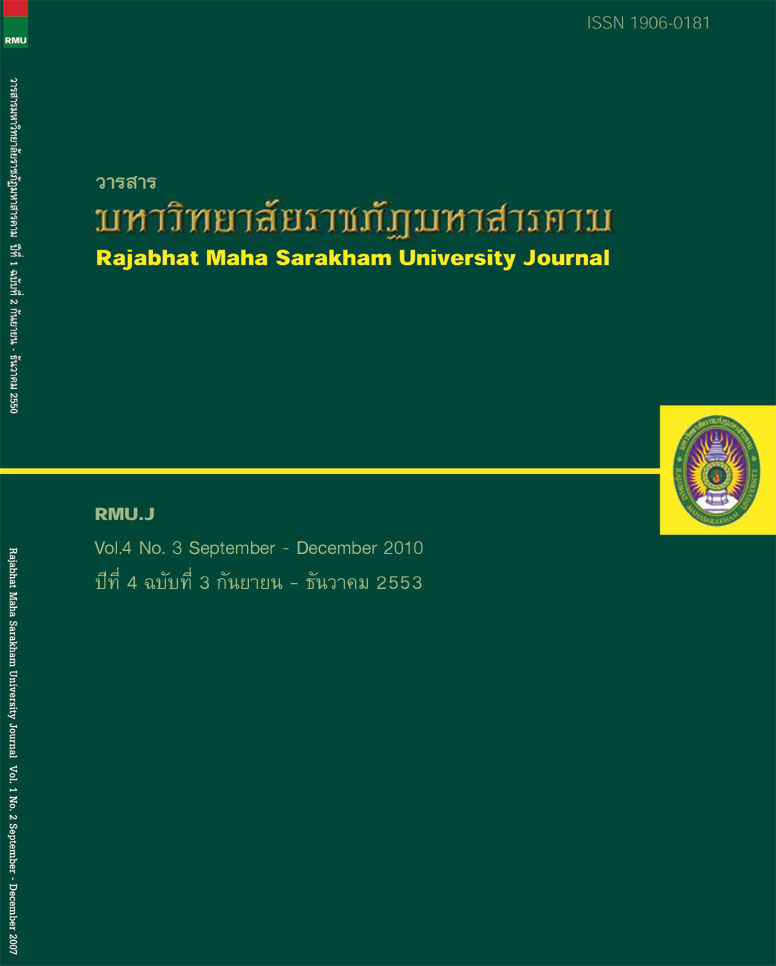การพัฒนาหลักสูตรฝึกอบรมวิทยากรเพื่อพัฒนาบุคลากร ศูนย์พัฒนาเด็กเล็ก องค์การบริหารส่วนตำบล The Development of Training Curriculum for Trainers to Develop the Personnel of Early Childhood Development Center in Sub-District Administration Organizations
Main Article Content
บทคัดย่อ
การวิจัยครั้งนี้มีวัตถุประสงค์เพื่อพัฒนาและหาประสิทธิภาพหลักสูตรฝึกอบรมวิทยากรเพื่อพัฒนาบุคลากรศูนย์พัฒนาเด็กเล็ก องค์การบริหารส่วนตำบล โดยกลุ่มตัวอย่างที่ใช้ในการวิจัยครั้งนี้ ได้แก่ ผู้ดูแลเด็ก ศูนย์พัฒนาเด็กเล็ก องค์การบริหารส่วนตำบล จังหวัดมหาสารคาม จำนวน 13 คน ใช้วิธีการดำเนินการวิจัยในลักษณะการวิจัยและพัฒนา (Research and Development) เครื่องมือที่ใช้ในการวิจัยคือชุดฝึกอบรมวิทยากรที่สร้างขึ้น และนำไปทำการวิจัยเชิงทดลอง (Experimental Research) แบบ One Group Pretest - Posttest design ในขั้นตอนการวิจัย และนำผลการวิจัยมาพัฒนาและปรับปรุงหลักสูตรฝึกอบรม ซึ่งการประเมินผลจะยึดรูปแบบการประเมินตามแบบ CIPP Model ของแดเนียล แอล สตัฟเฟิลบีม (Daniel L. Stufflebeam) ผลการวิจัยพบว่า
1. การประเมินสภาวะแวดล้อม (Context Evaluation : C) โดยการรวบรวมความคิดเห็นของผู้เชี่ยวชาญสรุปได้ว่า วัตถุประสงค์ของการฝึกอบรม คือ เพื่อให้ผู้เข้าอบรมมีความรู้และทักษะตลอดจนเจตคติที่ดีในการเป็นวิทยากรอีกทั้งได้แลกเปลี่ยนทัศนคติซึ่งกันและกันผู้เข้าอบรมมาจากผู้ดูแลเด็กศูนย์พัฒนาเด็กเล็ก องค์การบริหารส่วนตำบลมีประสบการณ์ในการดูแลเด็ก ไม่ต่ำกว่า 5 ปี จบการศึกษาระดับปริญญาตรีสาขาวิชาการศึกษาปฐมวัย หรือที่เกี่ยวข้อง ระยะ เวลาของการฝึกอบรมที่เหมาะสมคือ 4 วันทำการ จำนวน 13 คน/รุ่น การจัดการฝึกอบรมควรจัด ณ ห้องประชุมในเขตพื้นที่ อบรมทั้งภาคทฤษฎีและปฏิบัติ 8 หัวข้อเรื่อง คือ 1) การหาความจำเป็นในการฝึกอบรม 2) การเตรียมโครงการฝึกอบรม 3) การจัดทำแผนการสอนของวิทยากร 4) เทคนิคการฝึกอบรม 5) การพัฒนาบุคลิกภาพของวิทยากร 6) สื่อ/อุปกรณ์ในการฝึกอบรม 7) การจัดสภาพแวดล้อมในการฝึกอบรม 8) การประเมินผลการฝึกอบรม
2. การประเมินปัจจัยเบื้องต้น (Input Evaluation : I) โดยให้ผู้เชี่ยวชาญประเมินความสอดคล้องระหว่างหัวข้อการฝึกอบรมกับวัตถุประสงค์ และประเมินความสอดคล้องระหว่างวัตถุประสงค์กับแบบทดสอบ ผลปรากฏว่า ค่าดัชนีของความสอดคล้องในภาพรวมของทั้งสองรายการมีค่าเท่ากับ 0.75 ซึ่งมีความสอดคล้องกันสูง และการประเมินความคิดเห็นของผู้เชี่ยวชาญที่มีต่อชุดฝึกอบรม แบบสอบถามความคิดเห็นต่อการจัดการฝึกอบรม และแบบสอบถามติดตามผลหลังการฝึกอบรม ทั้ง 3 ชุด พบว่า ผู้เชี่ยวชาญมีความคิดเห็นอยู่ในระดับมากที่สุด สามารถใช้ประเมินผลการฝึกอบรมได้ในขั้นต่อไป จากนั้นผู้วิจัยได้นำชุดฝึกอบรมไปทดลองใช้ (Try out) กับผู้ดูแลเด็กจำนวน 15 คน เพื่อหาประสิทธิภาพของชุดฝึกอบรม พบว่ามีประสิทธิภาพ 85.57/84.44 ค่าความเชื่อมั่น (Reliability) ของแบบทดสอบ มีค่าระหว่าง 0.70 ถึง 0.93
3. การประเมินด้านกระบวนการ (Process Evaluation : P) ผู้วิจัยได้นำเอาชุดฝึกอบรมไปอบรมวิทยากร โดยเก็บรวบรวมข้อมูลกับกลุ่มตัวอย่างจำนวน 13 คน มีประสิทธิภาพ 86.85/85.64 ซึ่งสูงกว่าเกณฑ์ 80/80 ที่ตั้งไว้ เปรียบเทียบคะแนนก่อนอบรมและหลังอบรมพบว่าผู้เข้าฝึกอบรมมีความรู้เพิ่มขึ้นจากก่อนการเข้าฝึกอบรมอย่างมีนัยสำคัญทางสถิติที่ระดับ .05 และจากคะแนนภาคปฏิบัติพบว่าผู้เข้าอบรมได้คะแนนเฉลี่ย 76.61
4. การประเมินด้านผลผลิต (Product Evaluation : P) ผู้วิจัยได้ติดตามประเมินผลผู้เข้าอบรมโดยให้ผู้เข้าอบรมจำนวน 4 คนเป็นวิทยากรจัดอบรมให้ความรู้กับผู้ดูแลเด็กที่เข้าปฏิบัติหน้าที่ใหม่ จำนวน 15 คน ผลการนิเทศการสอนด้านทฤษฎี และปฏิบัติพบว่าภาพรวมอยู่ในระดับดี และผลความคิดเห็นของนักเรียนตัวอย่าง พบว่าผู้เข้าฝึกอบรมมีความคิดเห็นต่อการจัดฝึกอบรม โดยรวมมีความคิดเห็นอยู่ในระดับมากที่สุด และมีคะแนนภาคทฤษฎีมีค่าเฉลี่ยเท่ากับ 42 คะแนนปฏิบัติมีค่าเฉลี่ยเท่ากับ 11.07
The research aims to develop a training curriculum and to assess the efficiency of the training curriculum for trainers to develop the personnel of early childhood development centers in sub-district administration organizations. The sample subjects were 13 child care takers of early childhood development centers in sub-district administration organizations, Maha Sarakham province. The research and development methodology was employed. The research instruments were a constructed training package, and the training package was tried out by one group pretest-posttest design in the research stage. The training curriculum was then developed based on the research results, and the curriculum was tried out in the development stage. CIPP model proposed by Daniel L. Stufflebeam was employed to assess the efficiency of the curriculum.
The research results were as follows:
1. Context evaluation (C)
The data obtained from the experts during the context evaluation reveals that the objectives of the training course were to provide trainers with knowledge, professional skills, positive attitudes for being a trainer, and idea exchanges. The trainees are child care takers from early childhood development centers in sub-district administration organization with at least 5 years experience in their career, obtaining bachelor's degree in early childhood education or related field. The training should be held within 4 weekdays for 13 trainees at the meeting hall in the community area. The training was covered with eight topics based on both theoretical and practical parts, including training need analysis, training project preparation, trainers' lesson plan preparation, training techniques, trainers' personality development, materials for training, training environmental management, and evaluation after training.
2. Input Evaluation (I)
According to the input evaluation, the training topics and the training objectives, as well as the objectives and the test were assessed by the experts for the index of item objective congruence (IOC). The results reveal that the IOC value of the two aspects, as a whole, was 0.75, which was higher than the acceptable IOC value. The experts' opinion towards the training package, training management, and results after training was at a highest level, showing the effective training package for the next training stage. The training package was then tried out with 15 child care takers for the efficiency value, and the efficiency value of the training package was 85.57/84.44%, with the test reliability of .70 - .93.
3. Process Evaluation (P)
In the process evaluation, the training package was employed with 13 trainees. The efficiency value of the training package was 86.85/85.64, higher efficiency value than the required criteria (80/80). When compared the posttest with the pretest scores of the trainees, it was found that the posttest scores were higher than the pretest scores at the .05 level of significance. The mean score of the trainees in the practical part was 76.61.
4. Product Evaluation (P)
In the product evaluation aspect, four trainees were trained for acting as trainers giving knowledge to 15 inexperienced child care takers. Under the researcher's close supervision, it was found that the trainees' theoretical and practical knowledge, as a whole, was at a good level. The trainees' opinion towards the training management, as a whole, was at a highest level. The mean score of the trainees' theoretical part was 42, and the practical part was 11.07.
Article Details
1. บทความที่ลงตีพิมพ์ทุกเรื่องได้รับการตรวจทางวิชาการโดยผู้ประเมินอิสระ ผู้ทรงคุณวุฒิ (Peer Review) สาขาที่เกี่ยวข้อง อย่างน้อย 3 ท่าน ในรูปแบบ Double blind review
2. ข้อคิดเห็นใด ๆ ของบทความที่ลงตีพิมพ์ในวารสารมหาวิทยาลัยราชภัฏมหาสารคาม นี้เป็นของผู้เขียน คณะผู้จัดทำวารสารไม่จำเป็นต้องเห็นด้วย
3. กองบรรณาธิการวารสารมหาวิทยาลัยราชภัฏมหาสารคาม ไม่สงวนสิทธิ์การคัดลอกแต่ให้อ้างอิงแสดงที่มา

